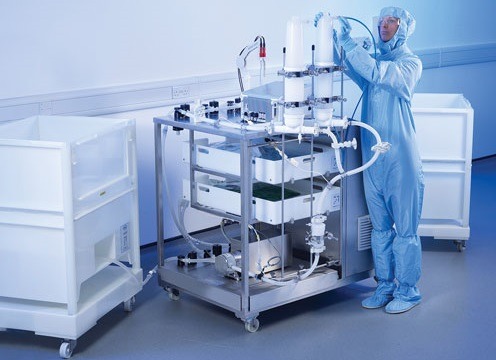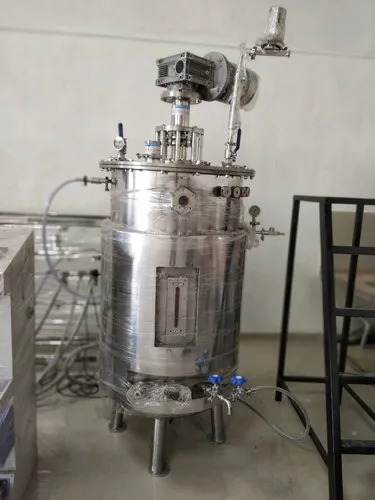#Bioreactors
Text
Can a Company Transform The Coffee Industry Using Biotechnology?
0 notes
Text
Europe Single-use Bioreactors Market by Product [Systems, Media Bags (2D, 3D), Filtration Assemblies], Type [Stirred Tank, Wave Induced], Cell [Mammalian, Bacterial, Yeast], Application [Commercial (Mab, Vaccine), Research], End User - Forecast to 2030
#Europe Single-use Bioreactors Market#Single-use Bioreactors Market#Single-use Bioreactors#bioreactors#bioprocessing#bioproduction#biotechnology
0 notes
Text
Single-Use Bioprocessing Market in the Quest for Efficient Biopharmaceutical Production
The global single-use bioprocessing market size is projected to reach USD 80.13 million by 2030, registering a compound annual growth rate (CAGR) of 16.24% over the forecast period, according to a new report by Grand View Research, Inc. The demand for single-use bioprocessing offerings is driven by the commercial advantages offered, including a reduction in costs and time required for bioprocessing operations. Originally used for monoclonal antibody production, single-use technologies are also gaining traction for cell and gene therapy manufacturing. As a result, broadening the scope of applications in biomanufacturing operations is likely to drive industry growth.

Single-use Bioprocessing Market Report Highlights
The simple & peripheral elements segment held the largest share in 2023 due to the significant adoption of these products as a result of a variety of customizable options available for bioprocessing applications
The upstream bioprocessing workflow segment accounted for the largest share in 2023. Continuous developments and betterment in technologies for upstream bioprocessing are driving the segment growth
North America was the leading region in 2023 due to the high R&D spending and growth of the biopharmaceutical manufacturing sector in the region
Furthermore, the presence of key players, such as Thermo Fisher Scientific, Inc. and Danaher Corp., is driving the regional market
The biopharmaceutical manufacturers end-use segment dominated the industry in 2023 and accounted for the maximum revenue share. This was due to the high demand for biologics and heavy investments in cell & gene therapy manufacturing
For More Details or Sample Copy please visit link @: Single-use Bioprocessing Market Report
Furthermore, strategic initiatives from key players are expanding the industry's growth prospects. For instance, in July 2021, Cytiva and Pall Corp. announced investment plans for capacity expansion over two years. Among other key products, more than USD 300 million were invested in single-use technologies, such as bioreactor bags for cell expansion, used to make personalized therapies and syringe filters for scientific research. Similarly, the growing adoption of single-use equipment for in-house and contract manufacturing has opened new avenues for the flow of investments in this space. The industry is witnessing significant advancements in several product portfolios, including disposable probes and sensors, stirring systems, bioreactor designs, and filtration technologies, which are expected to contribute to strong revenue growth.
The benefits offered by single-use bioprocessing systems have enabled biopharmaceutical manufacturers to offer their products faster to the market by introducing multi-product facilities, entering into partnerships, or outsourcing pipeline products for contract development and manufacturing. For instance, in January 2021, Sartorius AG partnered with RoosterBio, a leading supplier of human Mesenchymal Stem/Stromal Cells (hMSC). This collaboration aimed at advancing cell & gene therapy manufacturing by leveraging the single-use manufacturing technologies from Sartorius AG. The COVID-19 pandemic has generated new growth opportunities for key stakeholders in the industry.
#Single-Use Bioprocessing#Biomanufacturing#Bioprocessing Technology#Biopharmaceuticals#Disposable Technology#Sustainable Bioprocessing#Flexible Manufacturing#Bioproduction#BioProcess Containers#Bioreactors#Downstream Processing
0 notes
Text

𝐆𝐞𝐧𝐨𝐦𝐞 𝐄𝐝𝐢𝐭𝐢𝐧𝐠 𝐚𝐧𝐝 𝐂𝐑𝐈𝐒𝐏𝐑 𝐓𝐞𝐜𝐡𝐧𝐨𝐥𝐨𝐠𝐲: The development of the CRISPR-Cas9 system has revolutionized #geneticengineering and gene editing. Researchers are using this technology to modify genes in organisms
𝐒𝐲𝐧𝐭𝐡𝐞𝐭𝐢𝐜 𝐁𝐢𝐨𝐥𝐨𝐠𝐲: #syntheticbiology involves designing and constructing biological systems or organisms with novel functions or capabilities. This field has led to the creation of synthetic microbes for various applications
Visit @ https://symbiosisonlinepublishing.com/biotechnology/
#biotechnology#biology#environmentalbiotechnology#Bioreactors#immunobiotechnology#nanobiotechnology#AgriculturalBiotechnology#agricultural#MolecularGenetics#Therapeutics#stemcellresearch#journals#journal#pubmed#peerreview#OpenAccess#openaccessjournal#symbiosisonlinepublishing
0 notes
Text

Roch Bio: Cultivating Green Miracles, One Microbe at a Time - Revolutionizing Sustainable Agriculture!
Visit Here For More Info:- https://bit.ly/3qwcCFi
#RochBioFertilizerReactor #SustainableAgriTech #EcoFertilizer #BioReactors #GreenFarming #InnovativeAgriTech #FertilizerRevolution #AgriSolutions #EcoFriendlyFarm #BioFertilizerTech
#RochBioFertilizerReactor#SustainableAgriTech#EcoFertilizer#BioReactors#GreenFarming#InnovativeAgriTech#FertilizerRevolution#AgriSolutions#EcoFriendlyFarm#BioFertilizerTech
0 notes
Text
Bioreactors
Fluid BioSolutions: Your partner for advanced bioreactors. Elevate your bioprocessing with our cutting-edge solutions. Explore our bioreactor technologies now!
0 notes
Text
The Advantages of Stainless-Steel Fermenters
Introduction:
In the world of brewing, the choice of equipment plays a crucial role in achieving optimal results. Stainless steel (SS) fermenters have gained immense popularity among brewers for their exceptional performance and numerous benefits. In this blog, we will explore the advantages of using stainless steel fermenters, focusing on how they elevate brewing quality and efficiency. Join us as we uncover the reasons why stainless steel has become the preferred material for fermenter construction in the brewing industry.
Superior Hygiene and Cleanliness:
One of the primary benefits of stainless-steel fermenters is their excellent hygiene and cleanliness properties. Stainless steel is non-porous, preventing bacteria, contaminants, and odors from being absorbed into the material. This feature ensures a sanitary brewing environment, minimizing the risk of off-flavors and contamination.
Durability and Longevity:
Stainless steel fermenters are renowned for their exceptional durability and longevity. They are highly resistant to corrosion, rust, and staining, making them suitable for long-term use in challenging brewing conditions. The robustness of stainless steel ensures that fermenters can withstand rigorous cleaning, handling, and temperature variations without compromising their structural integrity.
Thermal Stability and Temperature Control:
Stainless steel exhibits excellent thermal conductivity, allowing for precise temperature control during fermentation. Fermenters made from stainless steel can effectively maintain desired fermentation temperatures, crucial for achieving consistent and high-quality brews. The ability to control temperature variations ensures optimal yeast activity, flavor development, and attenuation.
Easy Cleaning and Maintenance:
Stainless steel fermenters are designed with ease of cleaning and maintenance in mind. Their smooth surfaces and non-reactive nature facilitate straightforward cleaning procedures, minimizing the risk of residual flavors or contaminants. Stainless steel is also resistant to chemical agents commonly used in cleaning and sanitization, ensuring long-lasting hygiene and ease of maintenance.
Versatility and Flexibility:
Stainless steel fermenters offer versatility and flexibility to accommodate various brewing styles and volumes. They come in a range of sizes, from small-scale homebrewing to large commercial operations, catering to diverse brewing needs. Stainless steel fermenters can be customized with additional features like pressure relief valves, sampling ports, and integrated cooling jackets to further enhance brewing control and flexibility.
Aesthetic Appeal:
Apart from their functional advantages, SS fermenters also provide an aesthetic appeal. Their sleek and professional appearance adds a touch of elegance to brewing spaces, creating a visually appealing environment for brewers and visitors alike. Stainless steel's timeless and polished look reflects the dedication and professionalism of the brewing craft.
Conclusion: Stainless steel fermenters offer a myriad of benefits that significantly enhance brewing quality and efficiency. From superior hygiene and durability to precise temperature control and easy maintenance, the advantages of stainless steel in fermentation equipment are undeniable. Whether you are a homebrewer or operating a commercial brewery, investing in stainless steel fermenters can elevate your brewing process, ensuring consistent, high-quality brews and contributing to an overall exceptional brewing experience. Embrace the benefits of stainless steel and unlock the full potential of your brewing endeavors.
0 notes
Link
0 notes
Text
Bioreactors Market Size is expected to reach US$ 5,169.01 Mn by 2027
The global Bioreactors Market is segmented based on deployment, component, solution, application, and geography. The segmentation in this research study has been finalized post in-depth secondary research and extensive primary research. In addition, the market is also segmented on the basis of products offered by the leading participants in the industry in order to understand widely used market specific terminologies. Thus, we have incorporated the segments of the research and have finalized the market segmentation.
The bioreactors market is highly competitive in nature with considerable number of players, having a high level of consolidation overall revenue share. Most of the companies operating in the bioreactors market are present globally and have wide distribution and sales network through partnerships or authorized dealers.
The report segments the global Bioreactors Market based on application, type, service, technology, and region. Each chapter under this segmentation allows readers to grasp the nitty-gritty of the market. A magnified look at the segment-based analysis is aimed at giving the readers a closer look at the opportunities and threats in the market. It also addresses political scenarios that are expected to impact the market in both small and big ways. The report on the global Bioreactors Market examines changing regulatory scenarios to make accurate projections about potential investments. It also evaluates the risk for new entrants and the intensity of the competitive rivalry.
Get PDF Sample Copy @ https://www.theinsightpartners.com/sample/TIPHE100000880/
0 notes
Text
There are different sizes and shapes of bioreactors, ranging from liters to cubic meters
Any manufactured system or device that supports a biologically active environment is referred to as a bioreactor. In one instance, a bioreactor is a container used for chemical reactions involving living things or substances produced from them that are biochemically active. There are two types of this process: aerobic and anaerobic. These cylinder-shaped bioreactors, which can range in size from litres to cubic metres, are frequently composed of stainless steel. In the context of cell culture, it may also refer to a device or system made to grow cells or tissues. These tools are being created for use in biochemical and biological process engineering as well as tissue engineering.

Read More:
https://cmitoc.blogspot.com/2022/09/bioreactors-device-vessel-or-tank-that.html
0 notes
Text



More drawings while I play with new inks.
#suggestive#not worth tagging lol#inks for the ink-curious are salted seabreeze/voltaic arc then bioreactor/emerald fusion and lastly blossomed lotus/diamine scarlet#scarlet and voltaic arc are not new to me they just went well for details#going back to digital soon so's I have the almighty crtl-z back in my power bc freehanding ink with a hand tremor is kinda stressful lol#I have a retrospective thing I wanna finish before the year's out but SHINY NEW THING brain is hard to overcome#is the last week before nye even real?#i think not#inking things
77 notes
·
View notes
Text
Single-use Bioreactors Market by Product [Systems, Media Bags (2D, 3D), Filtration Assemblies], Type [Stirred-tank, Wave-induced], Cell [Mammalian, Bacterial, Yeast], Application [Commercial (Mab, Vaccine), Research], End User - Global Forecast to 2030
#Single-use Bioreactors Market#Single-use Bioreactors#bioreactors#bioprocessing#bioproduction#bioprocess#cell culture#cell therapy#biotech#biotechnology
0 notes
Text
I'm in Baby's First Management Role and i am having Baby's First Management Role Problems
I don't have time to write or send important messages because everyone needs my help all the time and my improv "yes, and" training is biting me in the ass like a bunch of piranhas in a spy movie
#we have enough stations and bioreactors to take down Thursday morning and set up Thursday afternoon#but not enough base bottles and vent traps! Shm!!!! how could you do this!!!!!!!!!
42 notes
·
View notes
Text
Application and Advantages of Lab Scale Fermenter
Understanding Lab-Scale Bioreactors
Lab-scale bioreactors, often referred to as benchtop bioreactors, are compact vessels designed to facilitate the growth and manipulation of various biological entities under controlled conditions. These reactors mimic the natural environment of microorganisms or cells, providing optimal conditions for proliferation, metabolism, and product formation.

Components and Design
The design of lab-scale bioreactors is meticulously crafted to emulate the conditions prevalent in industrial-scale fermenters while maintaining versatility and ease of operation. Key components typically include:
Vessel: The core of the bioreactor, where the biological culture resides. Vessels come in various sizes and configurations, accommodating different volumes and types of cultures.
Agitation System: Ensures uniform mixing of nutrients, gases, and metabolites within the culture. Agitation mechanisms may include stirrers, impellers, or spargers, depending on the specific requirements of the culture.
Temperature Control: Precise temperature regulation is essential for maintaining optimal growth conditions. Bioreactors are equipped with heating elements and cooling jackets, along with temperature probes and controllers to monitor and adjust temperature levels.
pH and Dissolved Oxygen Control: Maintaining appropriate pH and dissolved oxygen levels is crucial for cell viability and productivity. Bioreactors are equipped with sensors and controllers to regulate these parameters through the addition of acids, bases, or oxygen.
Monitoring and Control Systems: Advanced bioreactors are integrated with sophisticated monitoring and control systems, allowing real-time monitoring of key parameters such as temperature, pH, dissolved oxygen, and biomass concentration. Automated control algorithms facilitate precise adjustment of operating conditions to optimize culture performance.
Applications and Advantages of Lab Scale Bioreactor
The versatility of lab-scale bioreactors extends across a wide range of applications in biotechnology, pharmaceuticals, and academia:
Bioprocess Development: Lab-scale bioreactors serve as invaluable tools for the optimization and scale-up of bioprocesses. Researchers can fine-tune culture conditions, evaluate the impact of different parameters, and optimize productivity before transitioning to larger scales.
Cell Culture and Tissue Engineering: Bioreactors play a pivotal role in the cultivation of mammalian cells and tissues for various applications, including regenerative medicine, drug discovery, and tissue engineering. Controlled environments within bioreactors facilitate the growth and differentiation of cells into functional tissues.
Microbial Fermentation: Microbial fermentation processes, such as the production of antibiotics, enzymes, and biofuels, are extensively studied and optimized using lab-scale bioreactors. These reactors allow researchers to explore different microbial strains, media formulations, and process conditions to maximize product yields and quality.
Biological Research and Education: Bioreactors serve as indispensable tools for biological research and education, providing students and researchers with hands-on experience in culturing and manipulating biological systems. Benchtop bioreactors enable reproducible experimentation and data collection, fostering a deeper understanding of bioprocess principles and techniques.
Challenges and Future Directions
While lab-scale bioreactors offer tremendous potential, several challenges persist in their design and operation:
Scalability: Translating results from lab-scale bioreactors to larger industrial-scale fermenters remains a challenge due to differences in hydrodynamics, mass transfer, and mixing dynamics. Bridging this scalability gap requires advanced computational modeling, process optimization, and scale-up strategies.
Sterility and Contamination Control: Maintaining sterility and preventing contamination are critical aspects of bioreactor operation, particularly in cell culture and pharmaceutical applications. Robust sterilization protocols, aseptic techniques, and stringent quality control measures are essential to minimize the risk of contamination.
Process Intensification: Enhancing productivity and efficiency through process intensification strategies is a key focus area in bioreactor development. Integration of online monitoring and control systems, advanced analytics, and novel bioreactor designs can streamline bioprocesses and maximize resource utilization.
Conclusion
Lab-scale bioreactors represent the cornerstone of bioprocessing innovation, offering a platform for exploration, discovery, and optimization across diverse biological applications. As advances in biotechnology continue to accelerate, the role of lab-scale bioreactors in shaping the future of bioprocessing becomes increasingly pronounced. By addressing challenges, embracing technological advancements, and fostering interdisciplinary collaboration, we can unlock the full potential of lab-scale bioreactors and propel bioprocessing into a new era of sustainability, efficiency, and impact.
#lab scale bioreactor#lab scale bioreactor manufacturer#lab scale bioreactor supplier#lab scale bioreactor manufacturer in India#fermenter technologies
2 notes
·
View notes
Text

Now I'm tempted to figure out how a generator that runs of puppies and babies would work
#fic reading as ya do#fic snippet#probably like the bioreactor in subnautica#in go puppies and babies. they turn into a warm thin soup.
4 notes
·
View notes